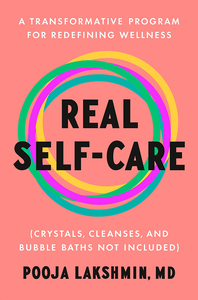How to Differentiate Between Real Self-Care and Faux Self-Care

In Real Self-Care, psychiatrist Pooja Lakshmin skewers wellness products and practices marketed to women as remedies, and offers a roadmap to more authentic and sustainable solutions for mental health. In this excerpt, she explains how it’s all a matter of framework
About a decade ago, disillusioned with her medical school training and mainstream medicine, and traumatized by the death of a patient, Pooja Lakshmin did the unthinkable: she blew up her marriage, dropped out of her highly competitive residency program and moved into a wellness commune that practiced orgasmic meditation. It was major. Though she extricated herself from the group two years later, the experience, and the hard-won lesson that no external, shiny wellness practice could fix her problems, were invaluable as she returned to medical training.
Today, Lakshmin specializes in women’s mental health, and in her active practice she helps women and people from marginalized communities who struggle with burnout, despair, depression, and anxiety. Part of her work is to help her patients identify faux self-care practices, ones that “keep us looking outward—comparing ourselves with others or striving for a certain type of perfection—which means it’s incapable of truly nourishing us in the long run.” Instead, she advocates for real self-care, which is “an internal process that involves making difficult decisions that will pay off tenfold in the long run as a life built around the relationships and activities that matter most to you.” Here, she offers guidance on how to distinguish between the two.
As a psychiatrist, I’m understandably interested in the connection between the explosion of faux self-care and the status of mental health treatment. While not everyone who engages with faux self-care needs professional mental health services, the symptoms of a major depressive disorder or a clinical anxiety disorder have quite a bit of overlap with those of burnout and chronic stress. But mental health treatment (like seeing a psychotherapist or a psychiatrist) is financially costly and typically not covered by insurance, and so remains inaccessible to many. It also takes time. The work of psychotherapy is not instantaneous—it can take months to see some progress (or to even get off a waiting list to be seen!). Similarly, trying to find the right medication can also take time. On the other hand, the seemingly easy and shiny solutions of faux self-care are, well, so much more simple and sexy. Why fight with your insurance company when you can buy a vitamin pack that your favourite influencer recommends, and it will be delivered to your door the next day?
So we can’t talk about faux self-care without talking about mental health treatment. We also can’t talk about any of this without acknowledging there is a huge gap in access to affordable mental health services. There are several parts to the interplay between mental health and wellness solutions—first, a lack of education and awareness for many women about what constitutes a clinical mental health condition. Then, there’s the stigma that still exists around seeing a therapist or a psychiatrist. Finally, once you’ve crossed all of those not-insignificant hurdles, there is the lack of insurance coverage, and the fact that finding access to a good therapist and psychiatrist is still only possible for the most privileged in our society. It’s in this context, where actual treatment for mental health conditions is inaccessible for the vast majority of folks, that our culture serves us faux self-care as a quick fix and as a poor substitute for professional help. I don’t mean to shame anyone here—in fact, when you are clinically depressed or anxious, finding a therapist and calling up your insurance company is even more difficult. It’s no wonder that we are vulnerable to the slick marketing of faux self-care. The time has come for self-care to evolve again, to take on a new definition. And that definition requires looking deeper, turning inward, and developing a reliable internal method for yourself—not one that has been prescribed for you by a wellness company or an influencer, but instead a solution that comes from you.
I know that some of you might enjoy and look forward to wellness practices—like yoga, meditation, or energy work. I’m not here to shame any of you who like to turn to wellness activities. In fact, in the years since I left the cult, I’ve been known to indulge in a Reiki session or two, even while writing this book! This might sound confusing to you, because the premise of the solution I’m proposing is seemingly counter to commodified wellness and so-called woowoo practices. Hear me out—one person’s yoga class can be profoundly nourishing, while another person’s yoga class can simply be an avoidance strategy or an escape. Like we just discussed, there are an infinite number of methods you can use to take care of yourself—my goal here is to offer you the guiding principles that you can implement to uncover your own unique methods. Real self-care is not a noun, it’s a verb. So it’s possible for the work of real self-care (boundary setting, self-compassion, and getting clear on values) to point you in the direction of a wellness activity. For example, if you have a hard conversation with your partner about needing space in your week for your yoga class and go on to treat yourself kindly during that yoga class and reflect explicitly about how a yoga practice is in alignment with your values, this is real self-care! The internal work that gets you to the yoga class is the bit that carries forth sustainably and reliably—perhaps in some seasons of your life the method will be yoga, and in other seasons the method will be different. The internal process—real self-care—is timeless.
When you first start out, it can be a little tricky to differentiate between faux self-care and real self-care. The following chart can help you spot the difference.
|
Faux Self-Care |
Real Self Care |
|
Prescribed from outside |
Originates within you |
|
A noun, typically describing an activity or a product |
A verb, describing an invisible, internal decision-making process |
|
Common examples: a yoga class, a meditation app, or a fancy face cream |
The internal process that goes on for you before you make the choice to attend the yoga class, listen to the meditation app, or put on the fancy face cream |
|
Maintains status quo in your relationship or family, and does nothing to change larger systems |
Allows you to get your needs met in your relationships, and can effect change in your family, workplace, and larger systems |
|
Often leaves you feeling further away from yourself |
Brings you closer to yourself and what’s most important to you |
|
Typically comes with feelings of guilt (either for never getting to it, or while you are engaging in it because you are neglecting other responsibilities) |
Requires learning to cope with feelings of guilt as part of the process |
|
Allows you to avoid or brush aside emotional costs or risks |
Comes with a short-term emotional cost, in order to reap longer-term emotional gains |
Now that you’re getting a better sense of the difference between real self-care and faux self-care, consider the following questions: What types of faux self-care have you tried? When do you find yourself most likely to turn to faux self-care? What aspect of faux self-care has you feeling the most disappointed? Have there been certain activities or wellness practices that have helped you? Are there certain feelings or thoughts about yourself that these activities elicit? In order to integrate these helpful wellness activities into your life, have you noticed changes in how you talk to yourself or how you navigate your relationships? If so, what changes have you noticed? Come back to these questions to distinguish for yourself which activities fall into the faux self-care category and which are aligned with real self-care. Over time, asking yourself these questions will feel second nature.

Adapted from Real Self-Care by Pooja Lakshmin, MD. Copyright © 2023 by Pooja Lakshmin. Published by arrangement with Penguin Life, an imprint of Penguin Publishing Group/Random House/The Knopf Doubleday Group, a division of Penguin Random House LLC.




